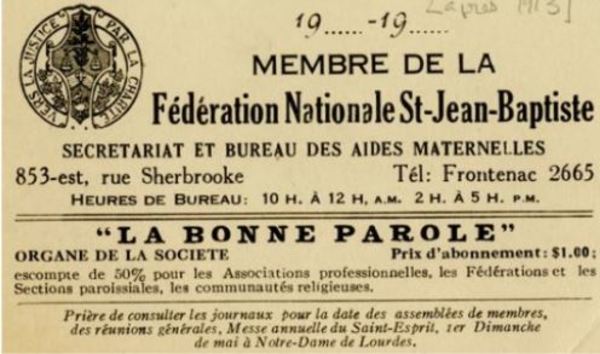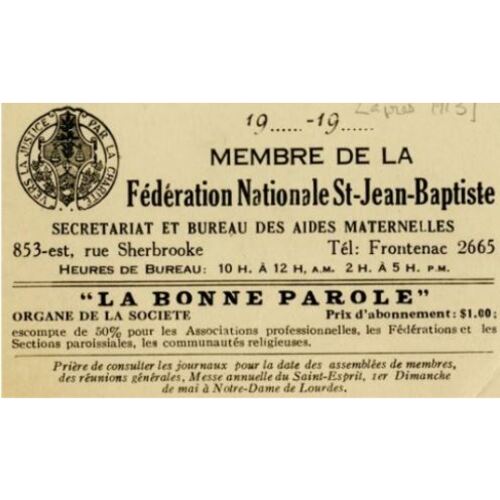
Source: Link
LAPORTE, MARIE-ANNE, factory worker, store clerk, and labour activist; b. 11 Oct. 1871 in the parish of Saint-Liguori, Que., daughter of Urgel Laporte, a day labourer, and Marie-Louise Perrault; d. unmarried 26 Nov. 1929 in Montreal and was buried in L’Assomption, Que.
Very little is known about Marie-Anne Laporte’s early life. She is believed to have arrived in the village of Hochelaga (Montreal) with her parents when she was quite young. It is thought that she worked at first as a weaver in a cotton mill, and then as a store clerk for Joseph-Wilbrod Moreau, the owner of a large retail business established in Hochelaga around 1897. From about 1910 and for much of her life, Marie-Anne Laporte devoted considerable energy to the Fédération Nationale Saint-Jean-Baptiste. She would make her most significant contribution, however, to the Association Professionnelle des Employées de Magasins, of which she was to be elected vice-president around 1916 and president in 1923. Although she relinquished the presidency of the organization in December 1925 for reasons of health, she would remain on its board of directors until 1928.
The Association Professionnelle des Demoiselles de Magasins was formed in the fall of 1906 and became affiliated with the Fédération Nationale Saint-Jean-Baptiste in 1907, the year that organization was founded [see Marie Lacoste*]. In April 1909 its name was changed to Association Professionnelle des Employées de Magasins. The federation sought to encourage the formation of professional associations rather than trade unions. Although the two kinds of organization were alike in seeking to protect the economic interests of their members, associations affiliated with the federation differed because they wanted to prepare them for their role in the family and in society. The aim of the Association Professionnelle des Employées de Magasins was to bring together the French Canadian Catholic saleswomen in Montreal, but from 1927 it would accept “persons other than saleswomen working at the counter” as members. Its motto was “Work, honesty, kindness.” Its efforts to foster the intellectual and moral development of working women – most of whom were young – and to defend their professional interests reflected closely the social doctrine of the Roman Catholic Church and the tenets of the federation. Its chief activities included offering members free evening courses in diction, sewing, the art of cooking, hygiene, fashion, singing, bookkeeping, and English. The association also maintained a library, organized cultural activities (including a choir), and held monthly meetings. In addition, it had an emergency fund that enabled members to receive free medical care and compensation for lost wages in case of illness. In 1927 an employment agency would be set up as well.
Like the federation, the association advocated measures to improve the daily lives of working women. Among other things, it made attempts – which usually proved fruitless – to ensure enforcement of the law (passed in 1908) requiring “bosses” to provide seats for “girls and women employed in stores.” Around 1915, on the initiative of Marie-Louise Brodeur [Marmette], it encouraged the formation of a league of women shoppers, with the objective of patronizing merchants who offered goods that were “irreproachable” in both value and quality and provided their female employees with the best working conditions in terms of hygiene, comfort, wages, and working hours. From 1917 it also tried to encourage women shoppers to do their shopping early during holiday periods so that store clerks would not be swamped at the last minute. On several occasions the association asked that stores be closed early. One such request, made in 1917 to the merchants in the east end of the city, would lead in 1919 and 1920 to a six-o’clock closing time on Saturdays during July and August. The Women’s Minimum Wage Act was passed in 1919 to meet the needs of female employees in industrial plants, and, with the backing of the association, the Fédération Nationale Saint-Jean-Baptiste demanded that female store employees be included in the categories of working women covered by the law (a goal achieved in 1934).
From 1906 to 1921 the Association Professionnelle des Employées de Magasins recruited 973 members. Although it had 200 members in 1911, its membership had dropped to 59 by 1929-30. The cause may have been the founding in 1918 of the Syndicat Catholique et National des Employés de Magasins (which, in fact, cooperated with the association) and possibly of other unions. There seems to have been a slight improvement later: in 1937-38 the association would have 125 members, and it was to pursue its activities at least until the 1960s.
Marie-Anne Laporte died on 26 Nov. 1929. The federation’s publication, La Bonne Parole, paid homage to her in its December issue. “What an example for women employed in stores. . . . And how she worked to improve the lot of those who earn their living as she earned hers!”
AC, Joliette, État civil, Catholiques, L’Assomption, 29 nov. 1929. ANQ-M, CE601-S51, 1er févr. 1899; CE605-S36, 12 oct. 1871; P120. LAC, RG 31, C1, 1871, Saint-Liguori, Que.; 1881, Hochelaga, village, Que.; 1891, 1901, Montreal, Hochelaga ward. “Beau mouvement philant[h]ropique,” La Patrie, 20 févr. 1915. Le Devoir, 28 nov. 1929. La Presse, 27 nov. 1929. La Bonne Parole (Montréal), 1 (1913)-18 (1930), esp. “Mlle Marie-Anne Laporte,” 17 (1929), no.12: 8. Le Duprex (Montréal), 4 (1929-30), esp. Églantine Phaneuf, “Une perte pour l’Association des employées de magasins,” 87. Nadia Fahmy-Eid et Lucie Piché, Si le travail m’était conté . . . autrement; les travailleuses de la CTCC-CSN: quelques fragments d’histoire, 1921-1976 ([Montréal], 1987). Marie Gérin-Lajoie, “Le syndicalisme féminin,” in Québécoises du 20e siècle: les étapes de la libération féminine au Québec, 1900-1974, Michèle Jean, édit. (2e éd., Montréal, 1977). Karine Hébert, “Une organisation maternaliste au Québec: la Fédération nationale Saint-Jean-Baptiste et la bataille pour le vote des femmes,” RHAF, 52 (1998-99): 315-44. Marie [Lacoste] Gérin-Lajoie, La Fédération nationale Saint-Jean-Baptiste et ses associations professionnelles (Montréal, 1911). Marie Lavigne et al., “La Fédération nationale Saint-Jean-Baptiste et les revendications féministes au début du 20e siècle,” in Travailleuses et féministes: les femmes dans la société québécoise, sous la dir. de Marie Lavigne et Yolande Pinard (Montréal, 1983), 199-216. La paroisse de L’Assomption: répertoire des sépultures, 1800-1980, Maurice Perreault, compil. (Ottawa, 1983). Yolande Pinard, “Le féminisme à Montréal au commencement du XXe siècle (1893-1920)” (mémoire de ma, univ. du Québec à Montréal, 1976). “Rapport de l’Association des employées de magasins,” in Fédération Nationale Saint-Jean-Baptiste, Recueil des œuvres fédérées ou l’Action des Canadiennes-françaises (Montréal, 1911), 140-46.
Cite This Article
Michelle Comeau, “LAPORTE, MARIE-ANNE,” in Dictionary of Canadian Biography, vol. 15, University of Toronto/Université Laval, 2003–, accessed April 26, 2025, https://www.biographi.ca/en/bio/laporte_marie_anne_15E.html.
The citation above shows the format for footnotes and endnotes according to the Chicago manual of style (16th edition). Information to be used in other citation formats:
| Permalink: | https://www.biographi.ca/en/bio/laporte_marie_anne_15E.html |
| Author of Article: | Michelle Comeau |
| Title of Article: | LAPORTE, MARIE-ANNE |
| Publication Name: | Dictionary of Canadian Biography, vol. 15 |
| Publisher: | University of Toronto/Université Laval |
| Year of revision: | 2005 |
| Access Date: | April 26, 2025 |



